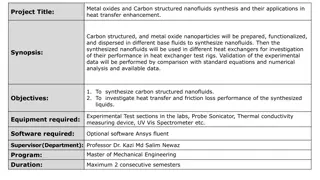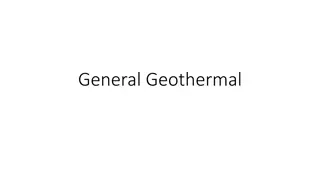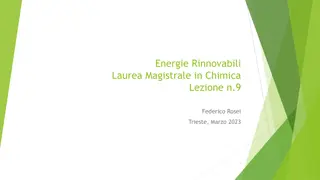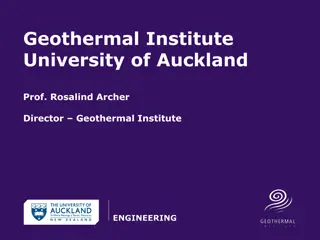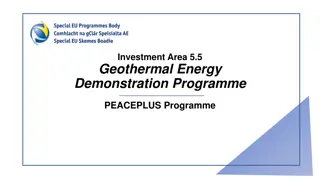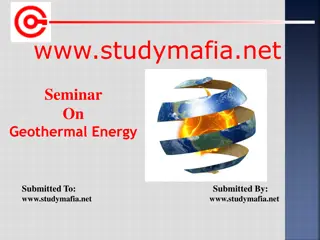Understanding Geothermal Systems and Heat Exchangers
This content provides a comprehensive overview of geothermal systems, focusing on open and closed loop heat exchangers. It covers basic geothermal terminology, loop configurations, thermal conductivity tests, and the efficiency of closed loop systems. Key concepts like heat pump basics and the influence of soil conditions on geothermal design are also explained.
Uploaded on Sep 17, 2024 | 0 Views
Download Presentation

Please find below an Image/Link to download the presentation.
The content on the website is provided AS IS for your information and personal use only. It may not be sold, licensed, or shared on other websites without obtaining consent from the author. Download presentation by click this link. If you encounter any issues during the download, it is possible that the publisher has removed the file from their server.
E N D
Presentation Transcript
Geothermal Systems OPEN LOOP AND CLOSED LOOP HEAT EXCHANGERS FOR GEOTHERMAL SYSTEMS Except where otherwise noted these materials are licensed Creative Commons Attribution 4.0 (CC BY)
The objective of this unit is to present the student with the basic geothermal terms and an understanding of heat exchangers used and how they are incorporated into the system. Upon completion, the student will have an understanding of the following: Basic geothermal terminology The basic layout of different loop configurations Series and parallel piping Ground temperature zones Objectives Thermal conductivity tests Open and closed loops Geothermal
The closed loop configurations provide a reliable way to achieve geothermal efficiencies when Well water is not available. If the water is of poor quality Not able to use because of codes Ground Source Heat Pumps Compared to Air Source Heat Pumps The ground heat exchanger portion uses the constant temperatures as a means of efficiently exchanging heat between the soil and heat pump. Summer example would be a standard home. An air source air conditioner on a hot day may have to reject heat to 95 F air while the ground may be 70 F. A 25 F difference makes the heat pump more efficient. Winter example of this would be the air source heat pump Working with an air temperature of 20 F. Ground is at 45 F; it is starting 25 F warmer. Allows for less work, making it more efficient Saves energy costs Geothermal
Certain laws govern all of nature. Heat pumps are built on these laws where hot and cold are relative terms. Heat exists at all temperatures all the way down to absolute zero, - 460 F. Heat flows from a region of higher temperature to a region of lower temperature, regardless of temperature difference. Heat Pump Basics All gasses become warmer when they are compressed. Matter exists as a solid, liquid, or gas. The temperature at which a material changes from a liquid to a gas (evaporates) or a gas to a liquid (condenses) depends on the current pressure of the material. All technicians troubleshoot on these concepts even if they do not realize it. Geothermal
Geothermal Loop Configurations WGisol. 2015. [CC-BY 4.0] Retrieved from https://en.wikipedia.org/wiki/File:ETI-FS_Loop_Diagrams,_01.26.11.jpg Geothermal
Soil conditions and characteristics differ across regions and can even differ across a job site. Some possible variations may include: Large compositions of rock to mainly soil Moisture content of the soil Moisture content is influenced by regional weather. Variations in the water table (static water level) Regardless of the variables that cause change, it is clear that along with these variables is a change in thermal properties. Geothermal Design Basics The Thermal Property of a substance refers to its temperature and its ability to conduct or transfer energy. At approximately 50 feet below the surface, the temperatures are constant; however, above that, the temperature fluctuates. This is the area where geothermal heat exchangers transfer heat. Therefore, when designing a low energy geothermal system, one must take into account soil temperatures. Geothermal
Geothermal design software will use deep earth formation temperatures for vertical heat exchangers, and for horizontal, the software will use subsurface temperatures (temperatures adjusted for seasonal influences). Geothermal Design Basics Environmental Protection Agency. [Public Domain]. Retrieved from https://www3.epa.gov/ceampubl/learn2model/part-two/onsite/tempmap.html Geothermal
Thermal conductivity is the other critical component of geothermal heat exchanger design. Thermal conductivity is the rate at which a subsurface formation can conduct energy. For a geothermal heat pump system, thermal conductivity is represented by: Geothermal Design Basics ??? ? ( ? ? ?? ? ??) or (? ? ??) There are published tables for conductivity It is recommended that you do not use them because they may not be precise to your conditions. Thermal conductivity can vary across the site. Geothermal
An open loop geothermal system will use a well or return water to the water table through a drainage ditch. Provides a cost-effective way, using a ground source heat pump By using a constant water temperature provided by well water, the system is capable of uniform capacity and high efficiency in heating and cooling. Open Loop Configurations Open loop systems operate at substantially higher temperatures and are not subject to the same extremes as a closed loop. Since it is open, the water quality needs to be determined and maintained at the highest level to prevent fouling. Geothermal
The total power required depends on the total dynamic feet of head (TDH) pressure against which the pump must overcome. Static Head: This is the vertical distance, in feet, the water must be lifted from the pumping water level in the well to the elevation of the expansion tank or pressure control. Friction Head: The pressure drop, in feet, caused by friction as the water moves through the piping, fittings, and components Pumping Power Pressure Head: The service pressure provided by the pump to the building. This is expressed as equivalent feet of head by multiplying the operating pressure in psi times 2.31ft/lb. ??? = ?????? ???? + ???????? ???? + (???????? ???? ? 2.31) Geothermal
Assume an application for a 3-ton open loop geothermal system. Water flow rate = 6 gpm Water pumping level = 100 ft Water supply pressure = 60 psi x 2.31 ft/psi = 138 Piping pressure drop = 12ft of head TDH = 100 + 138 + 12 = 250 ft of head Review the pump manufacture data and select a pump capable of 250ft TDH = 54 W per gpm of pump capacity Pump power average 54W/gpm x 6gpm = 324 W/hr The same 3-ton system in a closed loop would be 385W/hr, because the pump would require a high head loop pump. Pumping Power Example Geothermal
A drawdown test is performed on a well to determine the change in water level between the static water level (when pump is off) and the pumping water level. The water level will drop when the pump goes on, which will create a cone of depression. A minimal drawdown in a well, typically less than 30 feet for wells with a deep pump setting Open Loop Drawdown Test The well with a minimum drawdown will be the most dependable well. [ 3 ] Geothermal Didiervberghe [Public domain]. Retrieved from https://commons.wikimedia.org/wiki/File:Cross_section_of_a_drawdown_cone_of_a_pumping_well.JPG
Vertical loops Single-bore loops Multiple-bore series loops Multiple-bore parallel loop Reverse return For economic reasons, it is generally accepted that a depth of 50 feet is the practical minimum. Horizontal directional-bore loops Allows for an installation without disturbing the surface Requires a moist clay or silty clay soil for success Boring lengths range from 160 to 300 feet per ton. A ton of air conditioning is 12,000 Btu s. Common Loop Designs Geothermal
Common Loop Designs Series/Parallel U.S. Department of Energy. [Public Domain]. Retrieved from https://basc.pnnl.gov/resource-guides/geothermal- heat-pumps#quicktabs-guides=0 Geothermal
Common Vertical Loop Designs [ 6 ] G. Milne, C. Reardon, P. Ryan, M. Pavia [Public domain]. Retrieved from http://www.yourhome.gov.au/energy/heating-and-cooling Geothermal
Reverse return is a parallel design where the flow is equalized between the supply and return line. The first circuit on the supply manifold becomes the last circuit on the return manifold. All circuits will maintain the same pressure drop. Common Vertical Loop Designs: Each circuit will receive the flow, regardless of circulation volume. Reverse/Return U.S. Department of Energy. [Public Domain]. Retrieved from https://basc.pnnl.gov/resource-guides/geothermal-heat-pumps#quicktabs- guides=1 Geothermal
Single-pipe, single-trench loops The loop is placed in a narrow trench commonly 4-6 inches in width. Common burial depth of 4-6 feet Common Loop Designs: The loop should be positioned to allow for natural drainage: this will enhance heat transfer. Horizontal Trench Loops National Institutes of Health [Public domain]. Retrieved from https://www.orf.od.nih.gov/PoliciesAndGuidelines/Documents/Technical%20Bul letins/Ground%20Source%20Heat%20Pumps%20Part%20I%20of%20III%20Overv iew%20July%202013%20Bulletin_508.pdf Geothermal
Variation of a single pipe Common burial is 6 feet for the bottom pipe and 4 feet for the top. This design will require less trenching but more pipe. Common Loop Designs: Thermal interference can occur in this application. The installer needs to make sure the top pipe is the outgoing pipe, and the return pipe is the lower pipe. Multiple-Pipe Single-Trench Loops Helps promote a counterflow heat exchange Ohio Water Resources Council [Public domain]. Retrieved from https://epa.ohio.gov/portals/28/documents/sccgw/GHCS.pdf Geothermal
Relatively new in the geothermal field Advantages include: Needed heat transfer can be attained in a shorter/wider trench Worker hazard is reduced since it is a wider trench. Less trenching is required compared to a double-loop. Common Loop Designs: Disadvantage Careful consideration is required for soil types: a dry soil may require up to 1,000 per ton of cooling. Slinky Loops Mark Johnson. [Public domain]. Retrieved from https://commons.wikimedia.org/wiki/File:3-ton_Slinky_Loop.jpg Geothermal
Provides an economical alternative to horizontal or vertical loops Heat transfer provided by the direct water contact that creates convection currents. Convection currents are created by the thermal difference between the pond water and loop. Common Loop Designs: This is more efficient than a horizontal earth loop. Can lead to a 50% reduction in length compared to a horizontal earth loop Pond Loop Mark Johnson. [Public Domain]. Retrieved from https://commons.wikimedia.org/wiki/File:Pond_Loop_Being_Sunk.jpg Geothermal
Upon completion of this unit, students should be able to Define ground source and air source heat pumps Define heat pump basics for design Describe a thermal conductivity test Explain how an open loop system works Explain the significance of a drawdown test Explain the difference between different closed loop configurations Conclusions Explain reverse return piping Discuss the significance of the soil characteristics This presentation was prepared by Northeast Iowa Community College under award EG-17-004 from the Iowa Energy Center. Any opinions, findings, and conclusions or recommendations expressed in this material are those of the author(s) and do not necessarily reflect the views of the Iowa Energy Center. Geothermal

 undefined
undefined



 undefined
undefined









